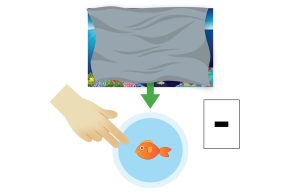 Four-year-old Angela is playing a game that involves keeping track of how many pretend fish are in a pretend ocean. Angela sees that there are three fish in the ocean. Next, the teacher covers up the ocean so the fish are hidden! Angela draws a card that instructs her how many fish to add or subtract from the ocean. She must figure out how many fish are in the ocean all together now. [The activity described here is from the DREME Guided Small Group Math Activity: Big Fish Story]
Four-year-old Angela is playing a game that involves keeping track of how many pretend fish are in a pretend ocean. Angela sees that there are three fish in the ocean. Next, the teacher covers up the ocean so the fish are hidden! Angela draws a card that instructs her how many fish to add or subtract from the ocean. She must figure out how many fish are in the ocean all together now. [The activity described here is from the DREME Guided Small Group Math Activity: Big Fish Story]
What Are Working Memory Skills? How Are They Used During Number Activities?
Working memory is the ability to simultaneously think about and manipulate information. In the vignette, Angela is likely using her working memory skills to remember and follow the steps of the game, keep track of how many fish she has already counted, and remember how many fish to add or take away. She needs to do all this to update the total number of fish in the ocean. Keeping track of information involves and may develop working memory skills.
How Can Teachers Build Children’s Working Memory Skills?
There are many ways to promote children’s working memory in preschool settings. For example, visual representations or Step Icons help children remember what step comes next in a given task. Also, the teacher can introduce activity adaptations to increase (for children who are ready for greater challenge) or decrease (for children who find the task too challenging) the working memory demands of a task. The DREME Guided Small Group Math Activities incorporate both Step Icons and activity adaptations to support the development of working memory skills.
Step Icons
Visual representations of the steps in a given activity can support working memory. Children can refer to the images as a reminder of what step comes next, if doing so without the icons is too challenging. As they get used to the activity, children rely more on their working memory and have less need for the Step Icons. Eventually, once they’ve learned all the steps, they may not need to rely on the Step Icons at all. The image on this page is an example of a Step Icon from the DREME Guided Small Group Math Activity: Big Fish Story.
Activity Adaptations: Using Hidden Versions
The version of Big Fish Story in which the ocean is visible involves low working memory demands because children can readily see how many fish are in the ocean at the start. Adding to the ocean takes some work, but no work is needed to remember how many fish there are to start. But when a child hides how many items are already in the ocean, as in the version of the activity in which the ocean is hidden, children must use their working memory skills to keep that number in mind as they add to it or subtract from it. Each time the number of items changes, children need to update their knowledge of how many items are hidden.
Why Should Teachers Focus on Promoting Children’s Working Memory?
Keeping information in mind while manipulating that information takes effort, and learning to update information benefits from repeated practice. The DREME Guided Small Group Math Activities were intentionally designed to provide many opportunities for students to keep track of items and quantities and to check that their partner is doing so accurately. By adding or subtracting while keeping the total amount in mind, children get to practice their math and executive function (EF) skills simultaneously.
Working memory is only one of the many interconnected abilities that make up EF. Other EF skills include sustained attention, inhibitory control, and cognitive flexibility. To learn more about these skills and their relevance to numbers and counting, see the additional DREME articles on executive function and math.